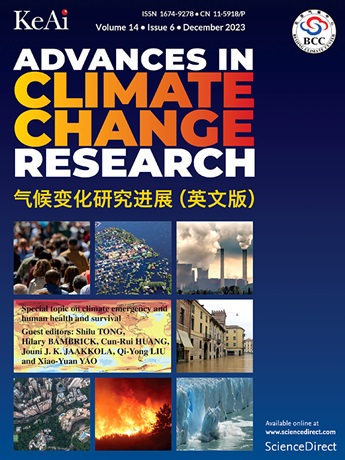气候增湿对青藏高原多年冻土工程稳定性构成严重威胁
IF 5.2
1区 地球科学
Q1 ENVIRONMENTAL SCIENCES
引用次数: 0
摘要
冻土是寒冷地区工程的基础,但对气候变化高度敏感。青藏高原气候变暖、降水变化和永久冻土退化与基础设施稳定性之间的联系机制尚不清楚。在这里,我们提出了一个多因素框架来量化气候对多年冻土工程稳定性的影响。研究结果表明,从2015年到2100年,冻土工程稳定性下降26.7%,稳定性极差的区域每10年增加0.3 × 104 km2 (SSP2-4.5)和0.6 × 104 km2 (SSP5-8.5)。稳定性较好的区域每10年分别收缩2.0 × 104 km2和2.9 × 104 km2。这些变化主要是由变暖和湿润的气候模式驱动的。西北和内陆地区保持工程稳定,而中部高原和祁连山南部较温暖、冰饱和地区退化较快。值得注意的是,寒冷的永久冻土比温暖的永久冻土变暖得更快,从而增加了其脆弱性。这些见解为指导未来冻土基础设施的设计、建设和维护提供了重要基础,使适应气候变化影响的工程策略得以发展。本文章由计算机程序翻译,如有差异,请以英文原文为准。
Climate warming and wetting poses a severe threat to permafrost engineering stability on the Qinghai‒Xizang Plateau
Permafrost underpins engineering in cold regions but is highly sensitive to climate change. The mechanisms linking climate warming, precipitation changes, and permafrost degradation to infrastructure stability remain poorly understood on the Qinghai‒Xizang Plateau (QXP). Here, we present a multi-factor framework to quantify climate impacts on permafrost engineering stability. Our findings reveal a 26.7% decline in permafrost engineering stability from 2015 to 2100, with areas of extremely poor stability expanding by 0.3 × 104 km2 per decade (SSP2-4.5) and 0.6 × 104 km2 per decade (SSP5-8.5). Meanwhile, regions with relatively better stability shrink by 2.0 × 104 km2 and 2.9 × 104 km2 per decade, respectively. These changes driven primarily by a warming and wetting climate pattern. Moreover, engineering stability is maintained in northwestern and interior regions, whereas warmer, ice-saturated areas in the central plateau and southern Qilian Mountains degrade rapidly. Notably, cold permafrost is warming faster than warm permafrost, increasing its vulnerability. These insights provide a critical basis for guiding the future design, construction, and maintenance of permafrost infrastructure, enabling the development of adaptive engineering strategies that account for projected climate change impacts.
求助全文
通过发布文献求助,成功后即可免费获取论文全文。
去求助
来源期刊

Advances in Climate Change Research
Earth and Planetary Sciences-Atmospheric Science
CiteScore
9.80
自引率
4.10%
发文量
424
审稿时长
107 days
期刊介绍:
Advances in Climate Change Research publishes scientific research and analyses on climate change and the interactions of climate change with society. This journal encompasses basic science and economic, social, and policy research, including studies on mitigation and adaptation to climate change.
Advances in Climate Change Research attempts to promote research in climate change and provide an impetus for the application of research achievements in numerous aspects, such as socioeconomic sustainable development, responses to the adaptation and mitigation of climate change, diplomatic negotiations of climate and environment policies, and the protection and exploitation of natural resources.
 求助内容:
求助内容: 应助结果提醒方式:
应助结果提醒方式:


